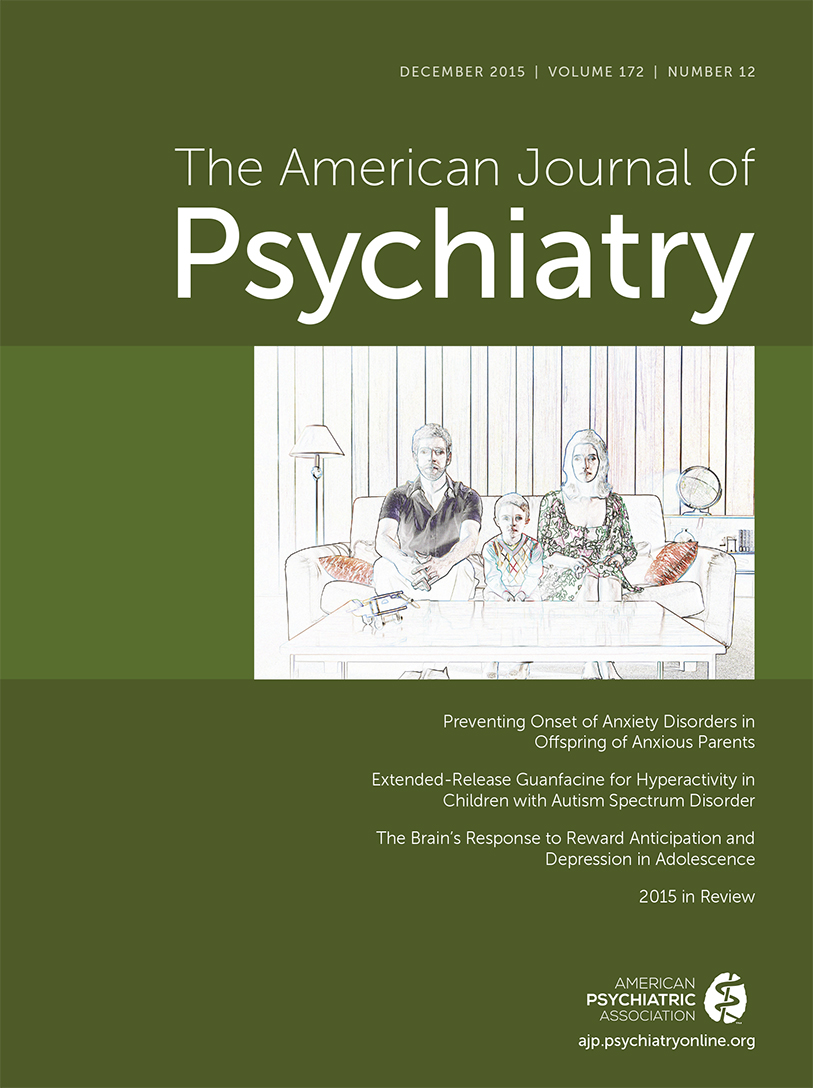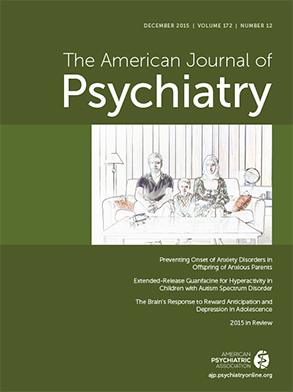Deployment stressors—most notably exposure to combat (
1)—have profound effects on mental health (
2). It is estimated that approximately 20% of military veterans develop posttraumatic stress disorder (PTSD) (
3), while approximately 7%−10% develop alcohol use disorders and 17% experience major depressive disorder (
4). These mental health issues have profound effects on social functioning and the ability to work, and they increase utilization of health care services (
5). Standardized behavioral treatments are helpful but have limited effect size (
6), and exposure-based interventions seem best suited for combat-related PTSD (
7). Yet a significant gap between treatment need and availability remains. Computerized treatment techniques might be able to address this gap. These methods are firmly rooted in cognitive science and provide a useful approach to specifically treat basic cognitive processing dysfunctions in PTSD. In this issue, Badura-Brack and colleagues (
8) address a critical question, i.e., For individuals with PTSD, is it better to train paying attention to safe
instead of threat stimuli
or to increase control of attention to
both safe and threat stimuli? and provide a provocative answer.
The “classical” answer has been that it is better to train individuals with anxiety disorders to pay more attention to “safe” stimuli (
9). Yet PTSD is different, with different studies finding both increased and decreased bias toward threat, respectively. Moreover, PTSD individuals seem to fluctuate between a focus on threat and a focus away from threat (avoidance), which has been termed attention bias variability. Badura-Brack and colleagues conducted a randomized controlled trial using an attentional task to examine the efficacy of attention bias modification versus attention control training. In fact, Badura-Brack and colleagues (
8) report on two randomized controlled trials with different number of sessions and different stimulus materials, which ultimately provided the same answer. Study 1 focused on 144 treatment-seeking individuals with combat-related PTSD from the Israel Defense Forces, of whom 52 were included in the study. Study 2 involved 76 veterans from Iraq and Afghanistan who had been screened for PTSD, of whom 46 participated in the study. For both studies, participants completed particular versions of the dot-probe task, one of which targeted attention bias to threat, while the other served as an attention control.
To understand the findings, it is important to consider what the specific task demands are and how individuals are being trained on the dot-probe task. First, during the dot-probe task an individual is asked to focus on the center of a computer screen. Second, two words (angry or neutral faces in study 2) are presented simultaneously above or below the center of the screen. Third, the person pushes a button as quickly as possible when he or she sees a target stimulus (letter E or F in study 1, “<” or “>” in study 2), which is presented in the same location as either the threat-related or neutral word (or face). If the person has no bias, then the reaction time should be the same whether the target appears at the location of either word (or face). However, if the person’s brain is more engaged in processing the threat-related word (or angry face) relative to the “safe” word (or neutral face), then the individual should be faster to respond to the target that appears in the same location as the threat word. Two measures provide an index of bias and variability. Threat-related attention bias is the difference in reaction time following a target at the threat versus the safe location. Attention bias variability is the variability of this measure across trials.
The same dot-probe procedure described above is also used for training. However, for attention bias modification and unbeknownst to the individual, the target only appears at the location of the neutral word (neutral face). Thus, attention bias modification implicitly trains individuals to focus their attention more toward the neutral (rather than the threat) stimulus. In comparison, during attention control training, individuals see the target at either the location of the threat word or the location of the safe word in a counterbalanced manner.
The authors found that all groups got better (had fewer PTSD symptoms), but the individuals undergoing attentional control training were significantly better than those undergoing attention bias modification. This effect was specific to PTSD-related symptoms and did not extend to depression symptoms, although there was a small effect on a depression measure in study 2. Moreover, in both studies, the attention bias became less variable for subjects who were part of the attention control training group but not those in the attention bias modification group. Lastly, these two main findings appear to be related; i.e., the individuals who showed the greatest reduction in variability of attentional bias were also the subjects who showed the greatest clinical benefit from attentional control training.
These findings are remarkable in a number of ways. First, the clinical effect on individuals with PTSD is exactly the opposite of what one would expect with anxiety disorder individuals. Usually, training “away from threat” helps to improve clinical symptoms in anxiety. In contrast, here the authors show that moderating attention toward and away from threat without emphasis on one or the other is most beneficial to PTSD patients. The specificity of this response stands out in unique contrast to traditional behavioral or pharmacologic treatment approaches for PTSD, i.e., providers use exposure-based therapy or antidepressants to treat both PTSD and anxiety disorders. Second, this study shows that it is not just the degree to which one is biased toward or away from threat but also how variable that bias is when repeatedly exposed to threat and safe stimuli that is an important treatment target. To some extent, this speaks to the consistency of biases or, said differently, how variable biases are from one event to the next. It appears that greater disease severity is associated with more bias variability, i.e., greater attention instability. Third, attentional control training helps to engage cognitive control processes, which involve inhibition of task-irrelevant information. Thus, beneficial effects from attention control training may be due to the fact that the individual is now able to successfully suppress paying attention to a threat stimulus if that stimulus does not serve to optimally respond to the task.
Whether working with a patient, writing a manuscript, or updating one’s Facebook page, cognitive control (
10) refers to processes that support the ability of individuals to regulate, coordinate, and sequence thoughts and actions according to internally maintained behavioral goals (
11). Control processes help to optimize behavior in situations when conflicting action tendencies have to be modified based on contextual information, and a “dual mechanisms of control” framework has been proposed (
11). Two modes are thought to modulate levels of cognitive control, i.e., a proactive control mode, which comprises a sustained process using goal-relevant information to optimally bias attention, and a reactive control mode, which consists of a corrective mechanism that is mobilized on a just-in-time basis to optimize behavioral performance in a high-conflict situation. Although the literature on cognitive control in depression and anxiety shows relatively few control-specific behavioral dysfunctions in these populations (
12), the current finding by Badura-Brack and colleagues might provide some support that training proactive control, i.e., maintaining optimal performance in the face of safety or threat, is clinically beneficial.
A Bayesian inference approach provides a quantitative framework to examine alterations in decision processes (
13). This approach relies on the fact that individuals come with preexisting beliefs that are then updated on the basis of their experience in a task, situation, or treatment—often in a mathematically prescribed manner. Specifically, two process parameters are thought to affect cognitive control and thus, subsequent decisions: 1) prior probability distributions, which reflect the individual’s belief state about what is likely to happen, and 2) the valuation process in response to rewards or punishments that occur in response to the person’s behavior (i.e., for correct or incorrect performance) (
14). Attention control training, as opposed to attention bias training, may teach the individual not to have a biased prior belief concerning which emotional state is associated with a target. At this stage, we need to find methods that will objectively inform development of the best intervention possible for each individual. This may imply that some individuals need to reduce variability by attending more to neutral stimuli, while others need to reduce variability by attending more to the threat stimuli. Integrating computational approaches and computerized training could go a long way toward increasing the likelihood of treatment response and optimizing response for each individual.
In addition to these theoretical implications, this study has also two very practical implications. First, it may not be beneficial for a therapist to exclusively focus on the safe aspect of stimuli that promote fear responses in patients with PTSD. Instead, a balanced evaluation of the safe and threat-related outcomes associated with sensitive stimuli may help to train the patient’s cognitive control system. Second, since cognitive control is such a critical process for the beneficial effect of attention training, these results provide another argument for the provider to highlight activities that promote or disrupt cognitive control. For example, exercise, positive mood, and good sleep hygiene promote cognitive control, whereas alcohol and illicit substances interfere with adequate cognitive control.
Badura-Brack and colleagues’ clearly surprising and important finding needs further exploration to better understand 1) the pathophysiology of PTSD, which is different from other anxiety disorders, and 2) how to optimize computerized interventions to help people with PTSD. Moreover, although these findings are intriguing, it is not clear whether they extend to individuals with PTSD that is not combat-related or if there could be modifications that could increase generalization to depressive symptoms. Lastly, we do not understand the neurobiological processes that underlie these effects, what basic brain systems, what neurochemical pathways, and what molecular mechanisms support these differential effects. In conclusion, this study should challenge us to reconceptualize the fundamental processing problems in PTSD and seek out new ways of improving the lives of those who have been affected by combat-related trauma.

